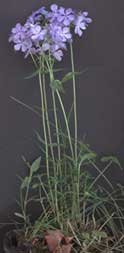
 |
||
 |
||
 |

The Illinois State Museum's botany program examines long-term changes in vegetation through studies of modern Illinois flora (plants) and preserved pollen grains from thousands of years ago. These studies show us
- how climates have changed
- how these changes have affected where certain plants grow
- which plants survive under which conditions. Using this information, botanists can provide suggestions about the best way to save today's dwindling plant species.
Palynologists are botanists who analyze pollen they find in samples of sediment to learn about ancient climates and landscapes. To identify the pollen, they consult the Museum's comparative collection of microscopic pollen.
Herbarium
Collection
Other
Museum botanists collect plants and record their current distribution (where
the plants live now). Each species is placed on a sheet with a leaf, a
stem, a flower, and a label with its collector, date and place of collection,
and scientific (Latin) name.
These specimens are stored in the herbarium, which is a kind of plant library collection. The comparative collection in the herbarium includes flowering plants and bryophytes (nonflowering plants such as mosses and liverworts), each pressed on its own sheet of special mounting board.
The herbarium contains more than 114,000 specimens and preserves examples of common, threatened, endangered, and extinct plants.
|
|
Copyright© 2000 Illinois State Museum Society